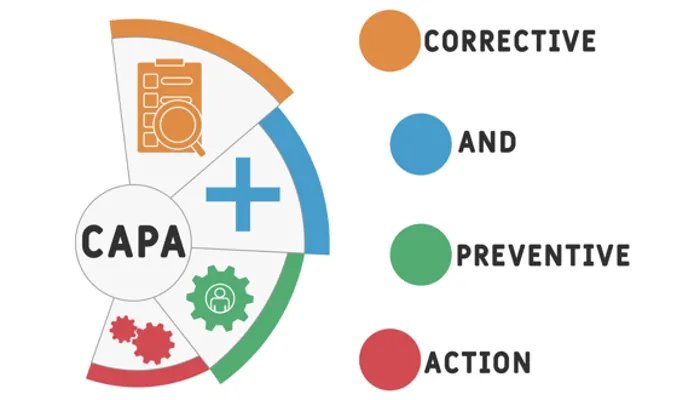Summary: Continuous improvement in organizations across industries: Whether you’re in manufacturing, healthcare, or any other sector, CAPA helps identify and resolve non-conformities to ensure compliance, reduce risks, and prevent future problems. But what exactly is CAPA? It involves a structured approach to addressing immediate issues (corrective actions) and proactively eliminating the root causes to prevent recurrence (preventive actions). This dual approach not only fixes current problems but also strengthens your processes for the long-term. In this article, we’ll delve into the significance of CAPA, the steps involved in its process, and why it is critical for sustaining operational excellence and regulatory compliance.
What is Corrective and Preventive Action (CAPA)?
Corrective and Preventive Action (CAPA) is a structured approach used by organizations to identify, address, and eliminate the root causes of non-conformities or undesirable situations. By focusing on both corrective actions (CA) to fix immediate issues and preventive actions (PA) to prevent future occurrences, CAPA supports continuous improvement in various processes, from manufacturing to documentation and quality systems. This dual approach not only resolves current problems but also strengthens organizational processes in the long term, enabling businesses to be more resilient to potential risks. In practice, CAPA is implemented after identifying issues that can impact the quality of a product or process. This structured approach helps organizations stay proactive, ensuring that future occurrences of the same problems are prevented. CAPA is key in fostering a culture of quality and continuous improvement, making it essential for businesses that aim to consistently meet customer expectations and regulatory requirements.
How effectively are you identifying and addressing quality issues?
An EQMS streamlines CAPA management for structured problem resolution.
Why is CAPA important?
The significance of CAPA lies in its ability to resolve immediate issues while preventing their recurrence. By systematically identifying the root causes of non-conformities, CAPA helps organizations reduce risks and improve product quality. It ensures compliance with industry standards and regulations, such as ISO 9000 or Good Manufacturing Practices (GMP), and minimizes the likelihood of future failures. By focusing on both corrective and preventive measures, CAPA enhances operational efficiency, reduces waste, and promotes long-term quality improvements. Furthermore, CAPA not only addresses non-conformities but also promotes an organization’s ability to learn from its mistakes. The insights gained through CAPA processes lead to more informed decision-making and process optimization. By prioritizing continuous improvement, CAPA contributes to better efficiency, safety, and overall quality across all levels of an organization, creating a sustainable approach to organizational success.
Corrective Action vs. Preventive Action
Corrective action (CA) and preventive action (PA) are both essential for effective quality management but serve distinct purposes. Corrective action (CA) focuses on addressing existing issues – such as defects, malfunctions, or deviations in a process – by identifying their root causes and eliminating them to prevent recurrence. Corrective action aims to fix the current problem and minimize the impact on product quality and compliance. Preventive action (PA), on the other hand, is more forward-looking and aims to identify and mitigate potential problems before they occur. This is often achieved through risk analysis, data trend monitoring, or regular system evaluations. Preventive action focuses on eliminating potential sources of non-conformities to prevent issues from arising in the future. It ensures that processes are optimized to avoid unnecessary risks, contributing to smoother operations. ISO 9000:2015 distinguishes between these two actions: corrective action deals with non-conformities that have already occurred, while preventive action focuses on preventing potential non-conformities from arising in the future. Both are crucial for maintaining a robust quality management system and ensuring that companies can produce high-quality products consistently.
CAPA Across Sectors: Key Industry Examples
| Industry | Issue | Corrective Action | Preventive Action |
|---|---|---|---|
| Manufacturing | Equipment failure | Repiar or replace faulty machinery | Implement regular maintenance schedule |
| Food Safety | Contamination riks | Dispose of contaminated product and retain staff | Update sanitation protocols and staff tarining |
| Healthcare | Medication error | Review patient records and correct medication errors | Introduce double.checking system for prescriptions |
| Construction | Safety hazard (e.g. fall) | Provide immediate first aid and secure the area | Install safety nets and conduct regular safety audits |
| IT | Data breach | Secure system and notify affected users | Regular security audits and staff awareness programs |
| Retail | Inventory discrepancy | Recount inventory and adjust records | Implement barcode scanning and improve stock training |
| Logistics | Delivery Delay | Investigate cause of delay and notify customers | Optimize route planning and communication systems |
| Energy | Equipment donwtime | Repair faulty equipment or replace parts | Schedule regular preventive checks and upgrades |
| Automotive | Product defect | Recall affected units and fix manufacturing issues | Enhance quality control checks during production |
| Pharmaceuticals | Batch production issue | Halth production and dispose of defective batch | Improve batch testing procedures and traceability |
What is a CAPA Plan?
A CAPA plan is a comprehensive framework used to address non-conformities and implement corrective and preventive measures. It begins with the identification of a problem or issue, followed by a thorough investigation and root cause analysis. After the root cause is identified, the CAPA plan outlines specific actions to resolve the current issue and prevent future occurrences. A well-designed CAPA plan includes clear timelines, responsibilities, and methods for verification and monitoring. The CAPA plan is often implemented by a cross-functional team, consisting of personnel from quality assurance, engineering, manufacturing, and other relevant departments. Collaboration among team members is essential for ensuring that corrective actions are appropriately executed and preventive measures are integrated into existing processes. Regular monitoring of the CAPA plan’s effectiveness is necessary to confirm that issues are resolved and improvements are sustained over time.
Root Cause Analysis: The Foundation of CAPA
Root Cause Analysis (RCA) is the critical first step in the CAPA process. This investigative approach focuses on identifying the underlying causes of an issue rather than merely addressing the symptoms. By uncovering the root cause, RCA enables organizations to implement corrective actions that truly solve the problem, rather than simply masking it temporarily. The RCA process uses several tools and techniques, such as the 5 Whys method, Fishbone Diagram (Ishikawa), or Failure Mode and Effect Analysis (FMEA), to systematically analyze and identify the causes of non-conformities. These tools help uncover both direct and indirect factors that contribute to the issue. Once the root causes are identified, the CAPA process can proceed to implement corrective actions and design preventive measures. This thorough approach ensures that the organization addresses systemic issues and improves its overall processes.
The CAPA Process
The CAPA process consists of several steps, each of which must be carefully followed to ensure a successful outcome. These steps are:
1. Document the Issue
The first step is to document the issue comprehensively. This includes recording how the problem was detected, its potential impact, and any immediate actions that have been taken. Proper documentation ensures that the problem is well-understood and lays the foundation for further investigation.
2. Assemble a Cross-Functional Team
A team of experts from various departments (such as quality assurance, manufacturing, engineering) is assembled to investigate the problem. This team uses their collective expertise to determine the root cause and suggest corrective actions.
3. Contain the Issue
The immediate goal is to contain the issue and prevent it from causing further damage. Containment actions may include stopping production, isolating affected products, or implementing temporary controls to limit the impact.
4. Identify the Root Cause
The root cause of the issue is determined through techniques like Root Cause Analysis (RCA) or the 5 Whys method. Identifying the root cause is essential for ensuring that corrective actions effectively address the source of the problem.
5. Implement Corrective Actions
Based on the findings from the root cause analysis, corrective actions are developed and implemented. These actions are designed to address the immediate issue and prevent recurrence.
6. Implement Preventive Actions
Once corrective actions are in place, preventive actions are identified and implemented to prevent similar issues from arising in the future. Preventive actions often involve process changes, training, or the introduction of new controls.
7. Verify the Effectiveness of Actions
After corrective and preventive actions have been implemented, their effectiveness must be verified. This ensures that the problem is fully resolved and that the corrective actions have been successful.
8. Document and Monitor the Results
Finally, the actions taken are documented, and their outcomes are monitored over time. This ensures that the CAPA process has been successful and that no similar issues occur in the future.
CAPA and Software Solutions with flowdit
For companies looking to streamline their CAPA processes, a software solution like flowdit can significantly enhance efficiency. flowdit provides an intuitive platform that enables organizations to track and document corrective and preventive actions systematically. By capturing real-time data, teams can address emerging issues more quickly and implement the necessary corrective and preventive measures with greater accuracy. flowdit integrates real-time communication, annotated checklists, and seamless collaboration features to ensure quick and effective problem resolution. Additionally, it provides tools for regular CAPA reviews and audits, ensuring that implemented actions remain effective and sustainable over time. By automating key aspects of the CAPA process, flowdit not only improves operational efficiency but also ensures compliance with industry regulations. The platform’s comprehensive documentation capabilities make it easier for teams to track progress, verify the effectiveness of actions, and maintain a complete record of all CAPA activities.
FAQ | CAPA
What is the primary purpose of CAPA in manufacturing?
CAPA is a vital quality management tool that ensures issues impacting product quality, compliance, or efficiency are identified, analyzed, and addressed to prevent recurrence or occurrence. It strengthens operational reliability by systematically correcting root causes and proactively mitigating risks. This structured approach supports regulatory compliance and enhances customer satisfaction.
What is the difference between corrective and preventive actions?
Corrective actions address existing problems by eliminating their root causes, while preventive actions focus on mitigating risks to stop potential issues from occurring. Together, they create a comprehensive risk management approach.
Why is preventive action critical in CAPA?
Preventive actions address potential risks before they escalate into actual issues, safeguarding operations against unplanned disruptions. By focusing on prediction rather than reaction, preventive measures reduce waste, improve resource allocation, and maintain consistent quality.
How does CAPA differ from root cause analysis?
Root cause analysis identifies the origin of a problem, while CAPA goes a step further by implementing corrective actions to resolve it and preventive measures to avoid future issues. CAPA formalizes these steps into a documented process, ensuring accountability and long-term resolution.
What are the key components of an effective CAPA process?
An effective CAPA process includes issue identification, root cause analysis, corrective and preventive actions, implementation, and verification. Each step must be meticulously documented to ensure traceability and regulatory compliance.
What is a CAPA report?
A CAPA (Corrective and Preventive Action) report serves as a structured tool for documenting defects and issues, along with the steps taken to address them. It typically includes information such as the location of the problem, the customer’s name and contact details, a description of the issue, whether the problem caused a product failure or injury, and any immediate corrective actions taken. The report may guide the user through the resolution process, recommend root cause analysis techniques (like 5 Whys or cause-and-effect analysis), and provide space for documenting findings. It may also offer direction on how to escalate or route the report based on the analysis results.
How do you measure the success of CAPA activities?
Success is measured by reduced recurrence of issues, improved compliance rates, and enhanced operational efficiency. Metrics like defect reduction, cost savings, and audit outcomes provide tangible proof of CAPA effectiveness.
Image: Adobe Stock – Copyright: © Nadezhda Kozhedub – stock.adobe.com





